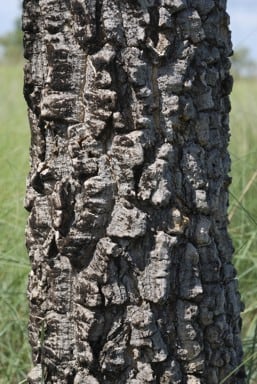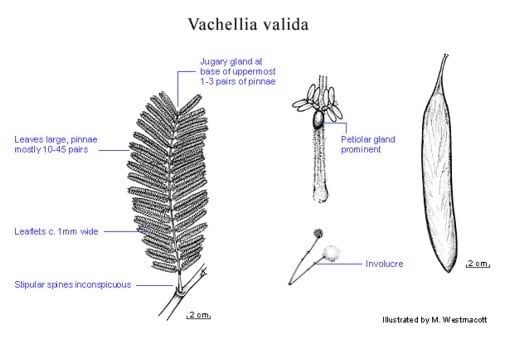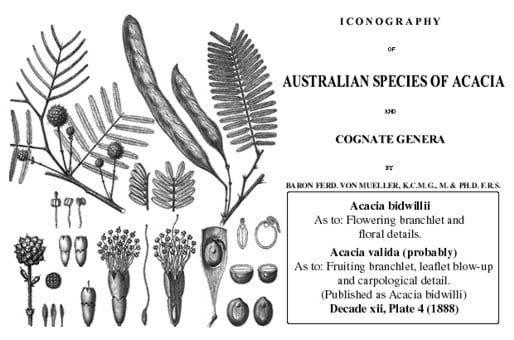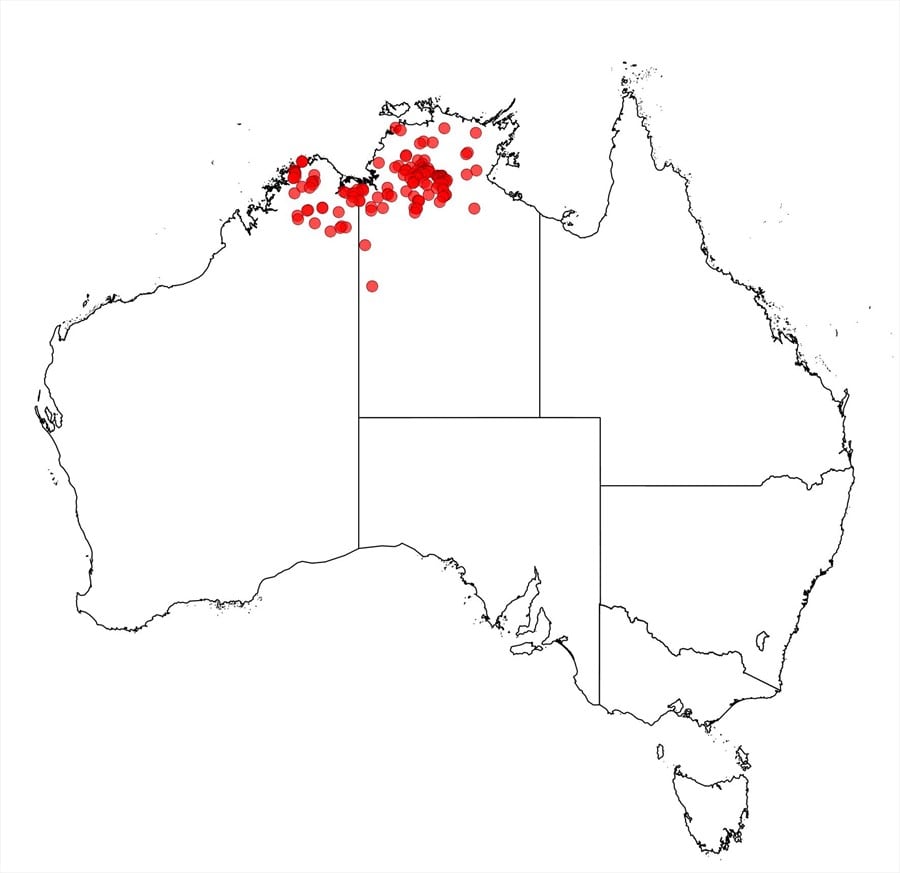Vachellia valida (Tindale & Kodela) Kodela
WATTLE
Acacias of Australia
Family
Fabaceae
Distribution
Occurs in the N.T. from the Tanami Tin Fields area (c. 20°S) N to Darwin, and in the Kimberley region of W.A. from c. 30 km S of Turkey Creek and Cave Spring Ra. (N of Kununurra) N to Port Warrender.
Description
Tree or occasionally shrub to 12 m high; branches often pendulous. Bark ±corky, often deeply fissured. Ultimate branchlets smooth, tomentose to velvety with long and short hairs (similar indumentum on leaf axes), becoming corky, furrowed, glabrous. Stipular spines 1.5–2 mm long, usually inconspicuous, often longer and curved on young plants and branchlets. Leaves: petiole 0.3–1.7 cm long, mostly with conspicuous pubescent gland at base of, or slightly below, lowest pair of pinnae; rachis (3.3–) 6.3–24.5 (–30.5) cm long, with gland (sometimes twinned) at base of uppermost 1–3 pairs of pinnae; pinnae (6–) 10–45 pairs (often subopposite), (0.7–) 1.5–4.2 (–6) cm long; pinnules 11–33 (–43) pairs, narrowly oblong or ±lanceolate, (1.5–) 1.8–5 (–6.3) mm long, (0.5–) 0.7–1.2 (–1.7) mm wide, obtuse to broadly rounded at apex, ciliate, with midnerve and lateral nerves usually visible. Inflorescences 1 (-5) in axils, simple or on a short axis or an extending raceme-like leafy shoot; peduncles (5–) 16–55 mm long, with involucel of bracts 1/3–1/2 (–2/3) way above base; heads globular, 14–27-flowered, pale yellow or creamy white, scented. Pods straight-sided or slightly constricted between seeds, ±flat or slightly convex over seeds, 4.5–25.5 cm long, 14–31.5 mm wide, woody, smooth with oblique to longitudinal nerves forming a ‘V’ pattern, glabrescent.
Phenology
Flowers July., Sept., Oct., probably periodic to Jan.; fruits Mar.–Oct.
Habitat
Grows in eucalypt woodland with grassy understorey or sometimes in open forest or grassland, often associated with Acacia tumida, A. platycarpa, A. holosericea s. lat. and/or A. hemignosta, in flat country, often near watercourses, in lateritic soil, red sand, sandy loams or clay loams, recorded on limestone and basalt/volcanics.
Specimens
W.A.: Port Warrender, C.R.Dunlop 5406 (CANB, DNA, NSW, PERTH); Carson Escarpment, 29 km ENE of Doongan HS, NE Kimberleys, M.Lazarides 8670 (CANB, NSW). N.T.: Scott Ck, C.Dunlop 4023 (DNA, NSW); 1/2 mile [0.8 km] SW of Dorisvale HS, M.Lazarides 6709 (BRI, CANB, K, NSW, PERTH); 14 km N of Mataranka on the Stuart Hwy, M.D.Tindale 6078 & C.Dunlop (BM, BRI, CANB, MO, PERTH).
Notes
Suckers freely from roots and often forms clumps, fide J.Brock, Top End Native Pl. 58 (1988). The pale brown gum of Kundart (local name) is eaten by the Ngarinyman people of the Victoria R. area of northern Australia, fide N.Smith et al., N. Terr. Botanical Bull. No. 16: 6 (1983), as A. calcigera ms. The leaves and pods are relished by cattle, fide R.J.Petheram & B.Kok, Pl. Kimberley Region W. Australia 357 (1983).
L.Pedley, Austrobaileya 6: 183 (2002), treated A. valida as a synonym of A. pallidifolia. Correct application of the latter species name is contingent upon resolution of the issue concerning its typification as discussed by P.G.Kodela & P.G.Wilson, Telopea 11: 240 (2006), whose interpretation is adopted here.
Vachellia valida was formerly confused with V. bidwillii, from which it differs by having mostly broader, hairy (later glabrescent) pods, often longer, tomentose to velvety rachises usually with jugary gland(s) near apex, and often more numerous pairs of pinnae and pinnules. Specimens were often labelled with an early manuscript name A. calcigera.
Part of the illustration in Mueller’s Iconography of A. bidwillii is probably A. valida, only the branchlet with inflorescences and the flower details are A. bidwillii (see below).
Based on molecular and other data Acacia sens. lat. is now considered as comprising a number of segregate genera, see J.T.Miller & D.S.Seigler, Austral. Syst. Bot. 25: 217-224 (2012) for overview. Many taxa in the former Acacia subg. Acacia are now referable to the genus Vachellia, including the one presented here.
FOA Reference
Data derived from Flora of Australia Volumes 11A (2001), 11B (2001) and 12 (1998), products of ABRS, ©Commonwealth of Australia
Author
P.G.Kodela, M.D.Tindale
This identification key and fact sheets are available as a mobile application:
URL: https://apps.lucidcentral.org/wattle/
© Copyright 2018. All rights reserved.











